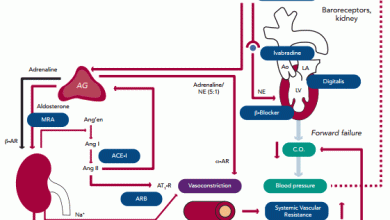Search results
Author(s):
Markus P Schlaich
,
Murray D Esler
Added:
3 years ago
The pathogenesis of primary hypertension is multifactorial. However, the sympathetic nervous system plays an important role in circulatory and metabolic control and has clearly been established as a major contributor to the development of hypertension, with blood pressure elevation being initiated and sustained by elevated sympathetic nervous activity. Increased sympathetic outflow to the heart…
View more
Author(s):
Gurushankar Govindarajan
,
James R Sowers
,
Craig S Stump
Added:
3 years ago
There has been an increase in the prevalence of diabetes mellitus over the past 40 years, both in the US and worldwide. The worldwide prevalence of diabetes in 2000 was approximately 2.8% and is estimated to grow to 4.4% by 2030. This translates to a projected rise of diabetes from 171 million in 2000 to well over 350 million in 2030. The epidemic of diabetes will continue to rise as there is…
View more
Author(s):
Naomi Abe
,
John D Bisognano
Added:
3 years ago
Hypertension is the most common chronic disease in the US, affecting 29% of the adult population.1 Once considered a benign, compensatory mechanism for ageing, high blood pressure (BP) is now recognised as an important risk factor for cardiovascular disease. It is estimated that inadequate BP control is responsible for 62% of cases of cerebrovascular disease, 49% of cases of ischemic heart…
View more
Author(s):
Alexandre Persu
,
Fadl Elmula M Fadl Elmula
,
Yu Jin
,
et al
Added:
3 years ago
Renal sympathetic denervation (RDN) has been introduced as a novel approach to treat patients with so-called resistant hypertension.1–3 The first randomised clinical trial showed an impressive 32/12 mmHg fall in blood pressure after six months in the intervention group (n=52) compared to the control group (n=54). However, with the recent publication of the Symplicity HTN-3 study in the US4 the…
View more
Author(s):
Maki Komiyama
,
Koji Hasegawa
Added:
3 years ago
Type 2 diabetes is a major risk factor for the development of cardiovascular disease (CVD) such as MI, and cerebrovascular incidents such as stroke. A substantial body of evidence has indicated that the proper management of blood glucose in people with diabetes can inhibit the progression of microvascular disease such as retinopathy and nephropathy.
Nevertheless, whether strict blood glucose…
View more
Author(s):
Philip Adamson
Added:
3 years ago
A growing appreciation of the prevalence of sleep breathing disorders, especially as co-morbidities of disease syndromes such as chronic heart failure, has increased interest in screening, diagnosis and treatment of obstructive and central sleep apnoea. Sleep apnoea diagnosis currently requires an overnight polysomnograhic evaluation in which the disease is defined as the number of times per hour…
View more
Author(s):
Douglas Bradley
Added:
1 year ago
ESC 22 - In this short interview filmed onsite at ESC Congress 2022, Dr Douglas Bradley (University of Toronto, Toronto, CA) discusses the findings of the ADVENT-HF Trial (NCT01128816).
ADVENT-HF was designed to determine if a respiratory device, Adaptive Servo Ventilation can reduce the risk of cardiovascular hospitalisations and death in patients with heart failure and sleep apnoea. 732…
View more
Author(s):
Martin H Deininger
,
Juergen Buttler
Added:
3 years ago
The association of electrocardiographic (ECG) abnormalities and intracerebral, particularly aneurysmal subarachnoid haemorrhage (SAH) is a well-known phenomenon. ECG alterations are observed in 50-100% of patients during the acute stage of SAH. Frequently, these effects are clinically not important. Some SAH patients, however, have structural cardiac damage with elevation of creatine kinase…
View more
Author(s):
AA Kroon
,
PW de Leeuw
Added:
3 years ago
Hypertension is a common and serious problem that is the major cause of morbidity and mortality worldwide.1–3 Over 70 million people in the US are affected by high blood pressure (BP) that requires treatment, and nearly one-third of the adult population in the US have a BP of ≥140/90mmHg, which is the defined cut-off value for hypertension.2,4 It is estimated that over 44% of people in Europe are…
View more
Author(s):
Christoph Maack
,
Michael Böhm
Added:
3 years ago
Chronic heart failure is the leading cause of hospitalisation in Germany1 and other European countries. It is the result of various cardiovascular diseases, such as myocardial infarction, arterial hypertension and valvular heart diseases. About 50 % of patients with heart failure have normal systolic, but impaired diastolic function, a condition termed heart failure with preserved ejection…
View more











